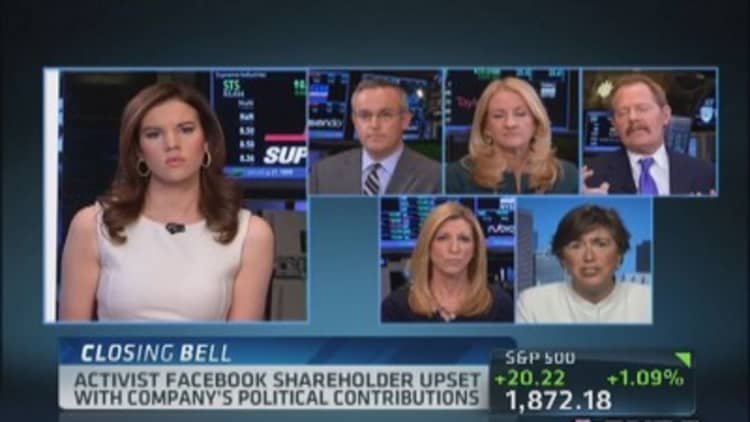What does the Bay of Pigs have to do with lack of diversity in boardrooms—a situation in corporate America that Morgan Stanley CFO Ruth Porat recently described as an ""?
More than you might think.
Part of what makes good decisions is a diversity of opinions. "When you're doing strategy for a corporation, you want a diverse group of people making decisions, not people from all the same schools and in all the same disciplines," said Brooke Harrington, a professor at the Copenhagen Business School. "They will converge rapidly on what they think will be the right answer."
And that's what leads to failures like the Bay of Pigs: The smartest people in the country graduating from the same schools and in the same profession, all converging on a consensus that's disastrous, because they fail to see all the potential outcomes. "[The Bay of Pigs] was the classic example," Harrington said.
It's not too much of a leap of faith from the Bay of Pigs to the issue of diversity in corporate America, or lack thereof, and potential corporate disasters in the making. It's a central part of the premise behind the work of DiversityInc, which just released its annual list of the 50 most diverse corporations (its methodology can be reviewed here). The list is limited to companies with at least 1,000 employees. Novartis took the top spot this year.
"If people are created equal, then it is logical to assume that talent is created equally," said Luke Visconti, CEO of DiversityInc. "Can you select enough talent from a homogeneous group to run a company well?"
New York City comptroller Scott Stringer recently targeted three companies for lack of women in the boardroom: Jarden, Microchip Technology and CF Industries (an agreement to add women to each company's board was recently reached). "As long-term shareowners, we rely on boards of directors to oversee risk and create sustainable value. Having diverse skills, experience and perspectives in the boardroom is critical to avoid group think," Stringer said by email.
Read MoreThe 2014 DiversityInc Top 50 list revealed (and why it matters)
There is a significant and growing body of empirical research linking board diversity to superior company performance. Both Stringer and Julie Goodridge, president and founder of NorthStar Asset Management, which is a woman-owned and -managed investing company, cited a study conducted by Credit Suisse. Researchers, for example, have found that female directors have better attendance records and that boards with female directors have better share price performance, higher return on equity and fewer accounting restatements.
Even Goodridge, though, a committed social investor who knows the work of DiversityInc and Luke Visconti well, said the idea of a diversity list has its own set of issues. Take Johnson & Johnson, No. 9 on this year's DiversityInc Top 50. Visconti cited the company's credo and the CEO's decision to have a floor-to-ceiling replication of it placed in his office, indicating the lengths J&J will go to make sure its culture is strong.
Read MorePresident Obama on gender pay gap
Goodridge, though, said a company like J&J exists in her company's portfolios as a stability factor. "They are good on some things—certainly diversity is one of them—but their stated policies are good. ... So are stated policies at Apple, Google, Facebook and Intel." (No Silicon Valley company made the DiversityInc Top 50 list. The only tech companies among the top 50 were IBM and Dell.)
If an investor wants to make a case based on diversity alone, there are "much more interesting and compelling companies that are smaller and more inventive than J&J," Goodridge said. "With mega-cap stocks, there are as many things they are good on as bad on," she added.
Goodridge also has a "diversity" pet peeve with J&J: the iconic Band-Aid still being manufactured in the same beige color matching one skin tone for decades—though the company has offered clear Band-Aids and versions for kids with colorful, cartoon characters for years as well. "They could have more Band-Aids matching the skin color of people buying them. ... I have been worried about Band-Aid color since I was 11. If they want to be seen as a diverse company, push that," she said.
Debating diversity
Companies can be diverse but also need to be creating products that are helpful, not harmful, to the diverse population they serve.Julie Goodridgefounder, NorthStar Asset Management
Pharmaceutical companies and financial services companies took up the most spots among the top 20 companies on the DiversityInc list: four big pharma and six financial services companies. Visconti cited sectors that rely on human capital and talent knowledge for success, and companies that need to gain community trust for their products.
"In pharma it is all about patents and getting the best scientists in the room and then making sure products are marketed and communicated in ways that communities trust," Visconti said. Take Novartis, No. 1 on this year's list. There is a huge gap in the U.S. between health care for the upper and lower classes. "That distrust has big implications for pharma," he said. Ultimately, it's a level of mistrust that can make or break incremental profits: the pharmaceutical giants spend the majority of money on a drug bringing it to market, and once it is out, if they can't extend its reach across social classes and ethnic groups, they miss out on a profit opportunity.
Or, as Goodridge put it, "Pharma and financial services are the biggest sectors with the broadest reach. It's not necessarily that they are the most diverse, but they see diversity as enough of an issue that they need to respond to surveys and stakeholders. They have attached their brand to this concept." She added, "They realize their business goes beyond white men, and for business reasons they have products that will be sold across cultural lines and gender lines and sexual-orientation lines."
Goodridge's view of MasterCard, No. 6 on this year's DiversityInc Top 50 list, raises the issue of whether acknowledging community issues is enough. Visconti sees a company with a multicultural marketing platform that is a pillar of why diversity succeeds on the bottom line. "MasterCard is an amazing company using diversity for sales. Their programs are multicultural, multi-ethnic and singularly successful," Visconti said.
"With MasterCard, the first thing I am thinking about is the impact of debt on low-income people," Goodridge said. "That's what I'm concerned about—economic inequality. I won't invest in them, no matter how much someone tells me they are diverse. No matter how much they are marketed as diverse, their product is essentially bad for many. ... Companies can be diverse but also need to be creating products helpful, not harmful, to the diverse population they serve," she said.
Read MoreA chat can go a long way in bridging income gap between sexes
Many of the top companies on the list have also faced high-profile discrimination lawsuits in the past, including Novartis and this year's No. 2 company, Sodexo—a factor that Visconti acknowledged but said was not the primary motivating factor for companies that opt to submit data for the DiversityInc survey.
"It is a big factor, and CEOs look in the mirror and say, 'We don't want to be this way,'" Visconti said, but he does not think financial damages from cases are the meaningful analysis. "It's more about reputational damage," Visconti said. "After verdicts, these companies felt a psychological impact, and a financial impact would follow if they didn't do anything. It's the inability to recruit after that counts."

Visconti cited a study of CEOs conducted by PWC indicating that scarcity of talent is a top concern for business leaders. "What is overall trajectory as talent becomes more and more scarce? This becomes more of a critical success issue," he said.
Investors, though, suggest a limit on diversity as a reason to make a call on a potential or existing investment.
Stringer said, "We don't buy or sell companies based on their diversity practices, whether to make a social statement or to avoid risk." But, he added, "we do actively engage our portfolio companies on their diversity policies, practices and disclosures." Most recently, the New York City comptroller said he called on 20 of its largest portfolio companies to provide quantitative reporting on the performance of their supplier-diversity programs.
If you are invested in a company where the boardroom is dominated by alpha males or graying males staring down at their smartphones, you shouldn't rush to judgment, but you might want to pause and reevaluate the company's long-term chances.
Goodridge said when companies don't make a list like the DiversityInc Top 50, "it doesn't mean we won't buy them, but it does mean there could be a problem."
The problem may arrive sooner than you think. "If you are not actively recruiting from diverse groups, it will extract difficult for your company in the near future—not 20 years from now," Visconti said.





